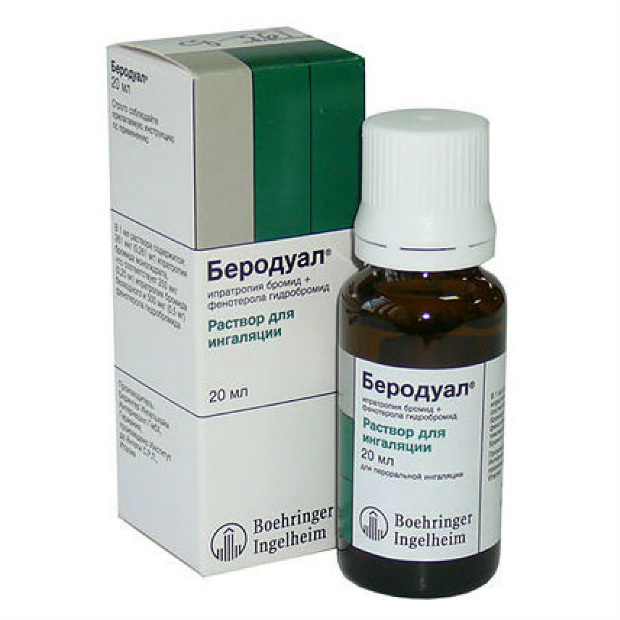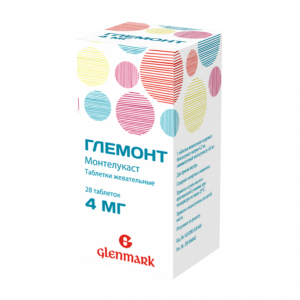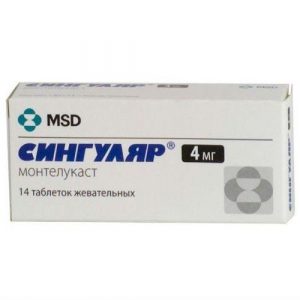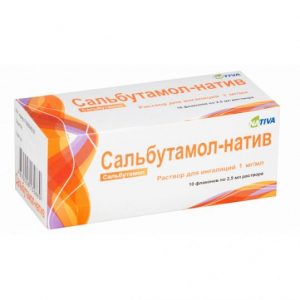Description
Release form
Inhalation solution.
Packaging
Bottle 20 ml.
Pharmacological action
Combined bronchodilator. It contains two components with bronchodilator activity: ipratropium bromide – m-anticholinergic and phenoterol hydrobromide – beta2-adrenergic agonist.
Bronchodilation with the inhalation of ipratropium bromide is mainly due to local and not systemic anticholinergic action.
Ipratropium bromide is a quaternary ammonium derivative with anticholinergic (parasympatolytic) properties. The drug inhibits the reflexes caused by the vagus nerve, counteracting the effects of acetylcholine, a mediator released from the ends of the vagus nerve. Anticholinergics prevent an increase in intracellular calcium concentration, which occurs due to the interaction of acetylcholine with a muscarinic receptor located on the smooth muscles of the bronchi. Calcium release is mediated by a system of secondary mediators, which include ITF (inositol triphosphate) and DAG (diacylglycerol).
In patients with bronchospasm associated with COPD (chronic bronchitis and emphysema), a significant improvement in lung function (increase in forced expiratory volume in 1 sec (FEV1) and peak expiratory flow rate by 15% or more) was observed for 15 minutes, the maximum effect was achieved after 1-2 hours and continued in most patients up to 6 hours after administration.
Ipratropium bromide does not adversely affect mucus secretion in the airways, mucociliary clearance, and gas exchange.
Phenoterol hydrobromide selectively stimulates 2-adrenergic receptors at a therapeutic dose. Stimulation of 1-adrenergic receptors occurs when using high doses (e.g. when prescribed for tocolytic action).
Fenoterol relaxes the smooth muscles of the bronchi and blood vessels and counteracts the development of bronchospastic reactions due to the effects of histamine, methacholine, cold air and allergens (immediate hypersensitivity reactions). Immediately after administration, fenoterol blocks the release of inflammatory mediators and bronchial obstruction from mast cells. In addition, with the use of phenoterol at a dose of 600 μg, an increase in mucociliary clearance was noted.
Beta-adrenergic effect of the drug on cardiac activity, such as an increase in heart rate and heart rate, is due to the vascular effect of fenoterol, stimulation of 2-adrenoreceptors of the heart, and when used in doses exceeding therapeutic, stimulation of 1-adrenergic receptors.
As with other beta-adrenergic drugs, a prolonged QTc interval was observed when using high doses. When using fenoterol using metered-dose aerosol inhalers (DAI), this effect was unstable and was observed in the case of doses exceeding the recommended ones. However, after the use of fenoterol using nebulizers (solution for inhalation in vials with a standard dose), the systemic effect may be higher than when using the drug using DAI in recommended doses. The clinical significance of these observations has not been established.
The most commonly observed effect of -adrenoreceptor agonists is tremor. Unlike effects on the smooth muscles of the bronchi, To systemic influences of β-adrenoreceptor agonists tolerance may develop. The clinical significance of this manifestation has not been elucidated.
With the combined use of ipratropium bromide and phenoterol, the bronchodilating effect is achieved by exposure to various pharmacological targets. These substances complement each other, as a result, the antispasmodic effect on the muscles of the bronchi is enhanced and a wide range of therapeutic effects is provided for bronchopulmonary diseases accompanied by constriction of the respiratory tract. The complementary effect is such that to achieve the desired effect, a lower dose of the beta-adrenergic component is required, which allows you to individually choose an effective dose with virtually no side effects.
Indications
Prevention and symptomatic treatment of chronic obstructive airway diseases with reversible airway obstruction, such as bronchial asthma and especially chronic obstructive pulmonary disease, chronic obstructive bronchitis with or without emphysema.
Contraindications
Hypertrophic obstructive cardiomyopathy.
Tachyarrhythmia.
I and III trimesters of pregnancy.
Hypersensitivity to fenoterol and other components of the drug.
Hypersensitivity to atropine-like drugs.
Caution: the drug should be prescribed for angle-closure glaucoma, arterial hypertension, diabetes mellitus, recent myocardial infarction (within the last 3 months), diseases of the heart and blood vessels (heart failure, coronary heart disease, heart disease, aortic stenosis, severe damage to the cerebral and peripheral arteries), hyperthyroidism, pheochromocytoma, prostatic hyperplasia, obstruction of the bladder neck, cystic fibrosis, II trimester of pregnancy, during breastfeeding.
Pregnancy and lactation
Preclinical studies and human experience show that fenoterol or ipratropium bromide do not have a negative effect on pregnancy.
The possibility of the inhibitory effect of fenoterol on uterine contractility should be considered.
The drug is contraindicated in the I and III trimesters (the possibility of weakening labor by fenoterol).
Use with caution in the second trimester of pregnancy.
Fenoterol passes into breast milk. No evidence has been obtained that ipratropium bromide passes into breast milk.
However, Berodual ® should be used with caution in nursing mothers.
Clinical data on the effect of the combination of ipratropium bromide and phenoterol hydrobromide on fertility are not known.
Special instructions
Patient should be informed that in case of unexpected rapid increase in shortness of breath (difficulty breathing), you should immediately consult a doctor.
It should be borne in mind that in patients with bronchial asthma, Berodual ® should be used only as necessary. In patients with mild chronic obstructive pulmonary disease, symptomatic treatment may be preferable to regular use.
In patients with bronchial asthma, one should be aware of the need to conduct or strengthen anti-inflammatory therapy to control the inflammatory process of the respiratory tract and the course of the disease.
Regular use of increasing doses of drugs containing beta2-adrenergic agonists, such as Berodual ®, for relief of bronchial obstruction can cause an uncontrolled worsening of the disease. In the case of increased bronchial obstruction, a simple increase in the dose of beta2-adrenergic agonists (including Berodual) is more than recommended for a long time, not only not justified, but also dangerous. To prevent life-threatening worsening of the course of the disease, consideration should be given to revising the patient’s treatment plan and adequate anti-inflammatory therapy with inhaled corticosteroids.
Patients with a history of cystic fibrosis may have gastrointestinal motility.
Other sympathomimetic bronchodilators should be prescribed simultaneously with Berodual only under medical supervision.
Patients should be instructed on the proper use of Berodual Inhalation Solution. To prevent the solution from getting into the eyes, it is recommended that the solution used with a nebulizer be inhaled through the mouthpiece. In the absence of a mouthpiece, a mask tightly fitting to the face should be used. Patients predisposed to the development of glaucoma should be especially careful about eye protection.
Berodual ® should be used with caution in patients predisposed to the development of acute angle glaucoma, or in patients with concomitant urinary tract obstruction (for example, prostatic hyperplasia or obstruction of the bladder neck).
In athletes, the use of Berodual in connection with the presence of phenoterol in its composition can lead to positive results of doping tests.
The preparation contains a preservative – benzalkonium chloride and a stabilizer – disodium edetate dihydrate. During inhalation, these components can cause bronchospasm in sensitive patients with airway hyperresponsiveness.
Influence on the ability to drive vehicles and control mechanisms
Studies of the effects of the drug on the ability to drive vehicles and use mechanisms have not been conducted. However, patients should be warned that during treatment with Berodual they may experience undesirable sensations such as dizziness, tremors, disturbances in eye accommodation, mydriasis, and blurred vision. Therefore, caution should be recommended when driving or using machinery. If patients experience the above-mentioned undesirable sensations, one should refrain from such potentially dangerous actions as driving a car or operating machinery.
Composition of
1 ml of inhalation solution contains: active substance:
261 ?g ipratropium bromide monohydrate, in terms of anhydrous ipratropium bromide (250 ?g) and 500 ?g phenoterol hydrobromide.
excipients:
benzalkonium chloride, disodium edetate dihydrate, sodium chloride, 1H hydrochloric acid, purified water.
Dosage and administration
Dose should be selected individually. During therapy, medical supervision is required (treatment should usually begin with the lowest recommended dose).
The following doses are recommended:
In adults (including the elderly) and adolescents over 12 years of age with acute attacks of bronchial asthma, the drug is prescribed in a dose of 1 ml (20 drops). This dose is usually enough to quickly stop the attacks of mild to moderate bronchospasm. In severe cases, for example, in patients in intensive care units, when the drug is ineffective in the doses indicated above, it may be necessary to use it in higher doses – up to 2.5 ml (50 drops). The maximum dose can reach 4.0 ml (80 drops). The maximum daily dose is 8 ml.
In case of moderate bronchospasm or as an adjuvant in the exercise of ventilation of the lungs, a dose with a lower level of 0.5 ml (10 drops) is recommended.
In children aged 6-12 years with acute attacks of bronchial asthma, it is recommended to prescribe a drug in a dose of 0.5-1 ml (10-20 drops) in severe cases – up to 2 ml (40 drops) in especially severe cases for acute relief of symptoms it is possible to use the drug (subject to medical supervision) in a maximum dose of 3 ml (60 drops). The maximum daily dose is 4 ml.
In cases of moderate bronchospasm or as an adjuvant in ventilating the lungs, the recommended dose is 0.5 ml (10 drops).
In children under the age of 6 years (body weight less than 22 kg) due to that information on the use of the drug in this age group is limited, it is recommended to use the following dose (only subject to medical supervision): 25 μg ipratropium bromide and 50 μg phenoterol hydrobromide = 0.1 ml (2 drops) per kg body weight (per dose) , but not more than 0.5 ml (10 drops) (per dose). The maximum daily dose is 1.5 ml.
Rules for using the drug
Inhalation solution should be used only for inhalation (with a suitable nebulizer) and should not be used orally.
Treatment should usually begin with the lowest recommended dose.
The recommended dose should be diluted with saline to a final volume of 3-4 ml and applied (completely) with a nebulizer. The solution for inhalation should not be diluted with distilled water.
Dilution of the solution should be carried out each time before use. Residues of the diluted solution should be destroyed.
The diluted solution should be used immediately after preparation.
The duration of inhalation can be controlled by spending the diluted volume.
Inhalation solution can be used using a variety of commercial nebulizer models. The dose reaching the lungs and the systemic dose depend on the type of nebulizer used and may be higher than the corresponding doses when using Berodual HFA and CFC metered-dose aerosol (which depends on the type of inhaler). In cases where there is wall oxygen, the solution is best used at a flow rate of 6-8 l / min.
Follow the instructions for use, maintenance and cleaning of the nebulizer.
Side effects of
Many of these undesirable effects may be due to the anticholinergic and beta-adrenergic properties of Berodual. Like any inhalation therapy, the use of Berodual can cause local irritation. Adverse drug reactions were determined on the basis of data obtained in clinical trials and during pharmacological supervision of the use of the drug after its registration.
The most common side effects reported in clinical trials have been coughing, dry mouth, headache, tremors, pharyngitis, nausea, dizziness, dysphonia, tachycardia, palpitations, vomiting, increased systolic blood pressure and nervousness.
On the part of the immune system: anaphylactic reaction, hypersensitivity.
From the side of metabolism: hypokalemia.
From the side of the nervous system and psyche: nervousness, agitation, mental disturbances, headache, tremor, dizziness.
From the side of the organ of vision: glaucoma, increased intraocular pressure, disturbances of accommodation, mydriasis, blurred vision, eye pain, corneal edema, conjunctival hyperemia, the appearance of a halo around objects.
From the cardiovascular system: tachycardia, palpitations, arrhythmias, atrial fibrillation, supraventricular tachycardia, myocardial ischemia, increased systolic blood pressure, increased diastolic blood pressure.
From the respiratory system: cough, pharyngitis, dysphonia, bronchospasm, pharyngeal irritation, pharyngeal edema, laryngospasm, paradoxical bronchospasm, dry throat.
From the digestive system: vomiting, nausea, dry mouth, stomatitis, glossitis, gastrointestinal motility, diarrhea, constipation, swelling of the oral cavity.
From the skin and subcutaneous tissues: urticaria, pruritus, angioedema, hyperhidrosis.
From the musculoskeletal system: muscle weakness, muscle spasm, myalgia.
From the urinary system: urinary retention.
Drug interactions
Beta-adrenergic agonists and anticholinergics, xanthine derivatives (including theophylline) can enhance the bronchodilatory effect of Berodual.
With the simultaneous use of other beta-adrenergic agonists, systemic anticholinergics, xanthine derivatives (e.g., theophylline), side effects may intensify. Perhaps a significant weakening of the bronchodilatory effect of Berodual with the simultaneous use of beta-blockers.
Hypokalemia associated with the use of beta-adrenergic agonists, can be enhanced by the simultaneous use of xanthine derivatives, corticosteroids and diuretics. This fact should be given special attention in the treatment of patients with severe forms of obstructive airway disease.
Hypokalemia may increase the risk of arrhythmias in patients receiving digoxin. In addition, hypoxia can increase the negative effect of hypokalemia on heart rate. In such cases, it is recommended to monitor serum potassium levels.
Beta-adrenergic agents should be used with caution in patients receiving MAO inhibitors and tricyclic antidepressants, as these drugs can enhance the effects of beta-adrenergic drugs.
Use of inhaled halogenated anesthetics, e.g. halothane, trichlorethylene or enflurane, may enhance the effect of beta-adrenergic agents on the cardiovascular system.
The combined use of Berodual with cromoglycetic acid and / or GCS increases the effectiveness of therapy.
overdose
Symptoms: Symptoms of overdose are usually associated mainly with the action of fenoterol (the appearance of symptoms associated with excessive stimulation of -adrenoceptors). The most likely occurrence of tachycardia, palpitations, tremors, increase or decrease in blood pressure, increase in differences between systolic and diastolic blood pressure, angina, arrhythmia, feelings of blood flow to the face, feeling of heaviness behind the sternum, increased bronchial obstruction, metabolic acidosis.
Possible symptoms of overdose due to the action of ipratropium bromide (such as dry mouth, impaired eye accommodation), are poorly expressed and are transient in nature, which is explained by the wide therapeutic dose range of this drug and its topical application.
Treatment: it is recommended to use sedatives, tranquilizers in severe cases – intensive care. As a specific antidote, it is possible to use -Adrenoreceptor blockers, preferably selective beta1-blockers. However, patients with bronchial asthma or chronic obstructive pulmonary disease should consider the possibility of increased bronchial obstruction under the influence of beta-blockers and carefully select their dose.
Storage Conditions
Keep out of the reach and sight of children at temperatures not exceeding 30 ° C.
Shelf life
5 years.
Fenoterol
dosage form
solution for inhalation
Prescribing
Prescribing
For adults, Nursing mothers as prescribed by the doctor, Prescribing doctor46 prescribing 25 Pregnant
Prescribing
For children from birth, For adults, Pregnant as prescribed by a doctor
Beringer Ingelyhaym, Austria




